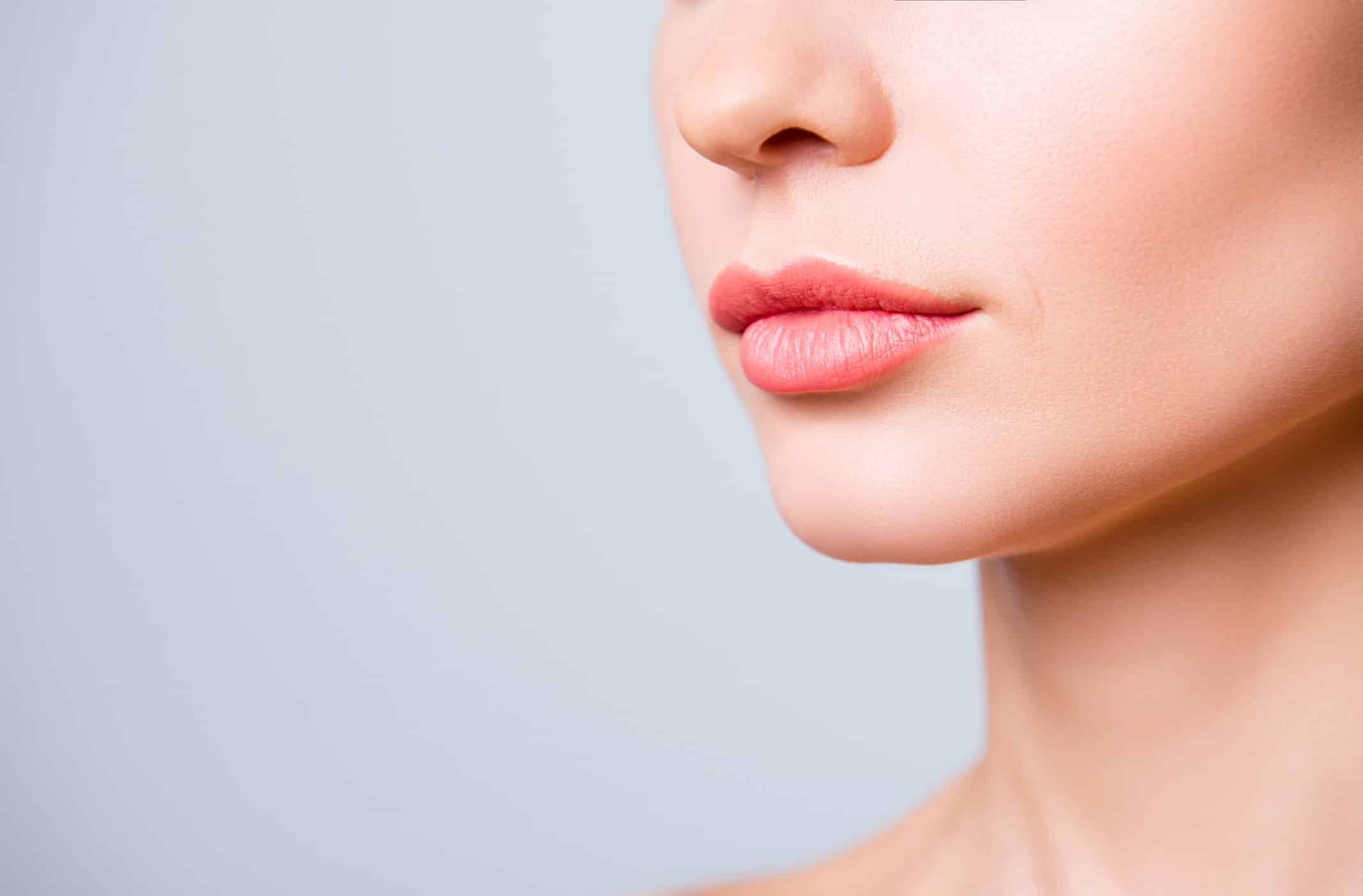

A Lip Lift is a simple and effective procedure used to elevate and volumize the upper lip. This Austin TX office-based procedure is performed through an incision just under the nose to improve the balance and length of the upper lip.
Who Is A Good Candidate For A Lip Lift?
Good candidates for this procedure can improve the shape and balance of the upper lip without the need for added volume. Often patients have already had a filler or implant performed on the upper lip and the tendency is the upper lip rolls inward without any improvement of volume because of the long upper lip. This is corrected with a Lip Lift and added volume may be added after the lip height is stable.
The best procedure for the lips depends on the upper lip length and balance in the middle third of the face along with upper tooth show. Dr. Trussler will discuss your lip lift goals to help you decide which treatment option is best for you to achieve the natural lips you desire.
What Are My Lip Lift Options?
A Lip Lift procedure is not for everyone and a long upper lip length is a necessity for a successful procedure. Age and genetics, as well as dentition, relate to why the upper lip elongates. Conservative shaping of the upper lip and vertical lip lines may be treated with fillers designed for the upper lip such as Volbella and Restylane Silk. Most patient’s inquiring about a lip lift have already undergone filler procedures.
Some of the lip options commonly used by Dr. Trussler for lip augmentation include:
- Hyaluronic Acid filler injections (Dr. Trussler prefers the use of Juvederm®)
- Fat injections using the patient’s own fat from another area of the body
- Collagen implant from your own body such as Palmaris Tendon harvested from the wrist
- Fascial (SMAS) implant from your own body usually harvested at the time of a facelift and performed during that procedure
- Lip Lift involves an incision below the nose which can naturally shape and lift the upper lip
- Diamond Procedure lifts the corners of the mouth with small incisions to help correct a down-turned lip
Each of these different types of lip augmentation offer patients benefits over other techniques, though biologic type augmentation techniques are preferred. You can discuss these options further with Dr. Trussler in order to determine which procedure is best for you.
What To Consider Before Your Lip Lift
It is important to discuss all options for treatment with Dr. Trussler in order to achieve the safest and most effective results for your lip lift procedure. A patient who presents for a lip lift procedure should be conservative with the amount of elevation and the location of elevation.
A lip lift will elevate and shape the central upper lip. If the corners of the mouth need elevation, a Diamond procedure should be considered. A Diamond procedure could be performed at the same time as a lip lift or as a separate procedure.


A lip lift is an effective lip augmentation technique with long lasting results though it does require an incision below the nose which may leave a small scar which fades over time. The sutures for a lip lift are left in place for 5 to 6 days and when removed the scar is nearly imperceptible and may be covered with make-up if needed.
What To Expect From The Lip Lift Treatment
Through a lip lift, the upper lip is improved in shape and volume with minimal downtime and few side effects. With realistic expectations and good overall health, most patients are satisfied with the results of this procedure. Of note, volume can be added with the addition of a hyaluronic acid filler layered on top of any lip lift technique, and these fillers can be dissolved with the use of a hyaluronidase.
Lip Lift Before & After

Lip Lift Procedure
Lip Lift procedures are performed on an outpatient basis and can usually be done in the office in less than an hour. Topical and injectable anesthesia is commonly used for the procedure. The upper lip is marked with the shape and vertical landmarks of the cupids bow maintained.
A gull-wing incision with conservative skin excision below the nose helps to eliminate the excess upper lip length while preserving the shape to the nose and improving the shape of the upper lip. The incision is closed with a combination of dissolvable deeper sutures and fine permanent sutures in the skin which are removed in under 1 week. Proper incision placement of lip lift is important in order to achieve optimal results. Ice is used immediately after to help decrease swelling.
Results Of A Lip Lift
The final result is usually appreciated at four weeks. After a lip lift, sutures are removed in 5 days and scar care is started at three weeks. The scar from this procedure will fade over time.
Depending on the amount of lift needed and degree of skin laxity, a minority of patients may require multiple treatments over time to maintain their desired results. Touch-ups can be performed after twelve weeks, and added volume could be added with injectable fillers if needed.
How Much Does a Lip Lift Cost?
On average, a lip lift surgery can cost anywhere between $2,000 and $6,000, depending on the patient’s needs and aesthetic goals. Because lip lifts are often cosmetic surgery, these procedures are not often covered by most healthcare insurance companies. However, our team is happy to work with all patients to organize a payment plan that fits your budget in order to help them achieve the lip look they’ve always wanted.
Does Age Play a Factor in the Lip Lift Procedure?
Typically, we recommend that patients are at least 18 years old before undergoing cosmetic surgery. Younger patients, such as those in their late teens or early to mid-twenties, often undergo lip lift surgery to achieve the same but longer-lasting plump-up look that lip fillers can create to bring volume to the appearance of the lips. The lip lift procedure is also popular among women in their 30s and 40s, as achieving this more plumped look can help bring out more youthful energy to the face.
What Are the Benefits of a Lip Lift?
A surgical lip lift can provide numerous benefits to patients. Unlike lip fillers, which bring added volume to only the lip area, surgical lip lifts can improve facial balancing by minimizing the space between the nose and the vermilion border. This can help bring a more proportional look to the features of the face. Lip lifts can also eliminate teeth showing and bring a more youthful look to downturned corners of the mouth. By not simply adding fillers to the upper and lower lips, the lip lift procedure targets more than just volume and can help improve a patient’s overall facial appearance. In addition, patients can also enjoy the results from lip lift surgeries for up to several years, as opposed to lip fillers, which only last several months before needing a re-touch.
Lip Lift Recovery


After a lip lift, patients may experience mild discomfort and swelling for about one week, although these side effects usually subside on their own and are limited with the use of ice. The upper lip may appear to be high and full at first, since there are deeper sutures used to lift the lip.
When Can I Return To My Normal Activities After My Lip Lift?
Most patients can return to work and other normal activities within one to two days after the procedure, although exercise and other strenuous activities should be avoided for a bit longer. Make-up can be applied to the lip lift incision line after the sutures are removed.
Read what our patients are saying!
"I was extremely pleased with Dr. Trussler and his staff. They were informative, responsive, and very helpful. The outcome of my procedure was better than I ever expected!"
Click here to read more reviews.
Contact Us
Whether you have a question or would like to set up a lip lift consultation in Austin, Texas, Dr. Trussler and his staff are here to help. Please fill out our contact form, or call our Austin office at 512-450-1077 to schedule an appointment. Start your journey to not only looking, but feeling better today!
Publication
- Trussler AP, Kawamoto HK, Wasson KL, Dickinson BP, Jackson E, Keagle JN, Jarrahy R, Bradley JP. Upper Lip Augmentation: Palmaris Longus Tendon as an Autologous. Plast Reconstr Surg 2008 Mar; 121(3): 1024-1032.
